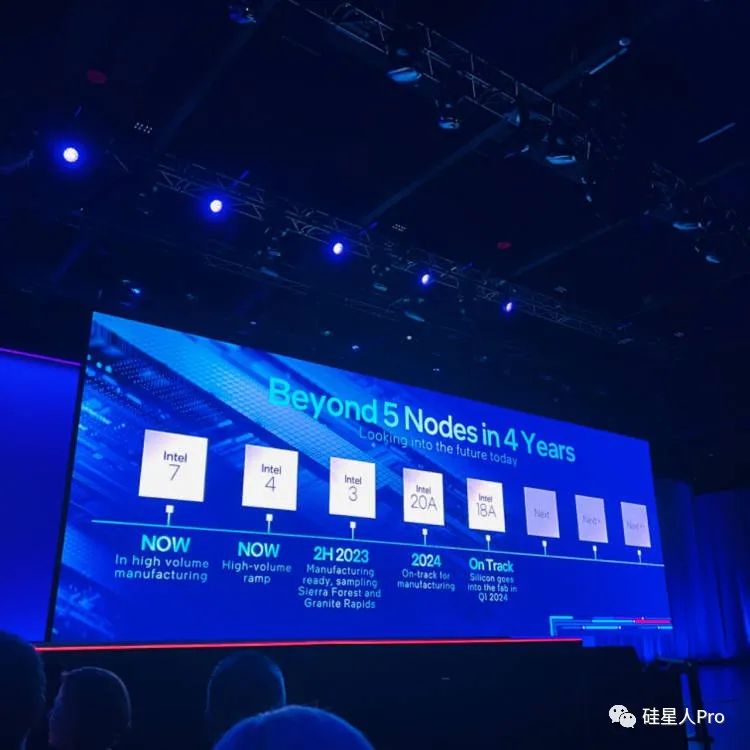Source: Silicon Star
Author: Wang Zhaoyang

Image Source: Generated by Wujie AI
In 2022, prior to the speech at the Intel conference, Intel CEO Pat Gelsinger was doing push-ups backstage; this year, he went straight to the stage for the keynote speech.
Applause filled the venue.
On September 19th, at the San Jose Convention Center, the CEO who is determined to bring Intel back to its peak appeared full of vitality. In the 90-minute keynote speech, Gelsinger, who was still warm from exercising, brought various heavyweight announcements: from the latest developments in the 288-core chip, to a series of next-generation chips with internal code names, to the world's top 15 supercomputers composed of 4000 Gaudi2, to the comprehensive launch of new packaging technology and developer cloud platform, the amount of information in this speech was enormous.
These developments cover various aspects, but it is obvious that all of this revolves around one theme: AI.
Shut down that Wi-Fi
If there is a moment in the myriad of announcements to showcase Intel's unique position in the AI wave, it might be the presentation by Rewind CEO Dan Siroker after taking the stage.
This is a hot startup company, and its product is like a time machine installed on your computer. It can help you review anything you have done or seen and process it using AI. He demonstrated how GPT-4 based on the network's capabilities can be used with Rewind, and Gelsinger made a request:
"Turn off that Wi-Fi."
After turning off the Wi-Fi, Dan selected the LLaMa on OpenVINO mode and entered the offline large model state.
He entered a question, a question mentioned in a story just shared by Gelsinger: What is his favorite sound?
Rewind answered, "His granddaughter calling him 'papa' (grandpa)." Applause filled the venue, indicating its ability to process data using the model's capabilities in an offline state.
Imagine the existence of such a large number of these terminal machines with the ability to have large models without being connected to the internet.
The key support for providing this capability is Intel's OpenVINO, which is Intel's AI inference and deployment runtime tool suite, providing choices for developers on client and edge platforms. It includes pre-trained models optimized for integration across operating systems and various cloud solutions, including multiple generative AI models such as Meta's Llama 2 model.
At a time when everyone is vying for large models, Intel chooses to start from its existing advantages. For this reason, Gelsinger also proposed the concept of an AI PC, and Intel is a necessity for these PCs to transform from PCs to AI PCs. If we apply the slogan that made Intel very successful, this time Gelsinger wants to say that only Intel Inside can be called an AI PC.
The AI PC can be realized, and the corresponding platform behind it is the Intel Core Ultra processor with the code name Meteor Lake, which is equipped with Intel's first integrated neural network processor (NPU) for AI acceleration and local inference on PCs. This is an important milestone in Intel's client processor roadmap. It is the first time that it uses Foveros packaging technology, integrates NPU, has independent graphics-level capabilities, and adopts the Intel 4 process node. It will be released on December 14th.
These actions reveal Intel's positioning in the wave of large models. First, it is to firmly grasp the opportunities in the end and data center and continue to make money with its customers. Second, it is to serve companies and developers like Rewind and complete a giant transformation.
The latter may seem more urgent, to the point that at this conference, Gelsinger raised not a GPU, CPU, or any chip for the first time, but a coupon for Intel's developer cloud.
Developers at the event can get one week of free use.
Percentages are everywhere
To achieve either of these two things, it is essential to impress others with capabilities, whether they are ecosystem partners or developers.
It is evident that the performance of this company is under pressure, so you can see that at this conference, Intel wants to fully demonstrate its confidence.
Therefore, at the conference, AI is everywhere, Intel is everywhere, and percentages and multiples are also everywhere:
"1.09 times"
This is the catch-up pace of Gaudi2 compared to Nvidia's H100. H100 shows only a slight performance advantage of 1.09 times (server) and 1.28 times (offline) compared to Gaudi2. Although still behind, being this close is already an achievement.
"150%"
This is the improvement in HBM capability of the 5nm Gaudi3 compared to the 7nm Gaudi2.
"99.9%"
This is the MLPerf result of Intel's Xeon CPU Max series for GPT-J, which is the first time it has submitted this test. It is the only CPU that can achieve 99.9% accuracy and provides up to 64 GB of high-bandwidth memory.
"240%"
This is the performance improvement per watt of the Sierra Forest processor with 288 cores and high-efficiency cores (E-core) compared to the fourth-generation Xeon, which is expected to increase rack density by 2.5 times.
"90%"
This is the increase in downloads of OpenVINO compared to last year. Companies including ai.io and Fit:Match demonstrated on-site how they use OpenVINO to accelerate applications: ai.io evaluates athletes' performance using OpenVINO; Fit:Match innovates the retail and health industries through OpenVINO, helping consumers find better-fitting clothes.
In addition to data, Gelsinger also showcased several important partnerships.
Among them are long-time allies, such as Microsoft. Gelsinger stated that the two sides will soon collaborate on Copilot. There are also a new batch of hot startups, such as StabilityAI. Gelsinger announced that a large AI supercomputer will be built entirely using Intel Xeon processors and 4000 Intel Gaudi2 accelerators, with Stability AI as its main customer.
There are also some strong alliances, such as the test chip packaging based on the Universal Chiplet Interconnect Express (UCIe) open standard, which integrates Intel's UCIe IP chiplet based on the Intel 3 process node and Synopsys UCIe IP chiplet based on the TSMC N3E process node. These chiplets are interconnected using advanced packaging technology called Embedded Multi-die Interconnect Bridge (EMIB).

At the same time, Intel once again introduced the Intel Ignite program, aiming to build and support the developer and startup company ecosystem. Gelsinger mentioned several startup companies participating in the Ignite program during the keynote speech.
An entrepreneur told Silicon Star that when Gelsinger communicated with them, he asked them for their feedback the most, how Intel's products could help them, and where improvements were needed.
He's keeping a low profile.
2024, 2024, still 2024!
These developments ultimately point to the ultimate judgment standard, the "Four Years, Five Process Nodes" plan set by Gelsinger for himself.
Gelsinger stated that Intel's "Four Years, Five Process Nodes" plan is progressing smoothly, with Intel 7 already in mass production, Intel 4 ready for production, and Intel 3 progressing according to plan, targeting the end of 2023. Gelsinger is aiming to restore Intel's strong execution and delivery capabilities.
During the keynote speech, Gelsinger showcased the first batch of test chips for the Intel Arrow Lake processor built on the Intel 20A process node. Arrow Lake will be launched for the client market in 2024. Intel 20A will be the first process node to apply PowerVia backside power delivery technology and the new all-around gate transistor RibbonFET. The Intel 18A process node, which will also use these two technologies, is progressing according to plan and will be ready for production in the second half of 2024.

The fifth-generation Intel Xeon processor will be released on December 14th, and Sierra Forest will be launched in the first half of 2024.
The native software development platform Strata for edge computing will also be launched in 2024. It is a way to horizontally expand the infrastructure needed for intelligent edge and hybrid AI and integrate Intel and third-party vertical applications into one ecosystem.
You may have also noticed that 2024 appears in multiple key product plans. As a critical year in the four-year plan, 2024 is crucial for Intel, needless to say.
An Intel executive even told me that this may be the most important year for this generation, or in their careers:
"Our own technological progress and the readiness of our customers' technology will align in this year, bringing about crucial changes."
In this information-packed conference, Intel hopes to tell everyone that as an "infrastructure company" that makes AI possible, companies today that want to develop AI cannot bypass it. Intel is waiting for you at every stage of AI, even if some are still "second options."
But what Intel wants the outside world to know is that by 2024, it will not be satisfied with just being "there." Its counterattack has truly begun.
免责声明:本文章仅代表作者个人观点,不代表本平台的立场和观点。本文章仅供信息分享,不构成对任何人的任何投资建议。用户与作者之间的任何争议,与本平台无关。如网页中刊载的文章或图片涉及侵权,请提供相关的权利证明和身份证明发送邮件到support@aicoin.com,本平台相关工作人员将会进行核查。




